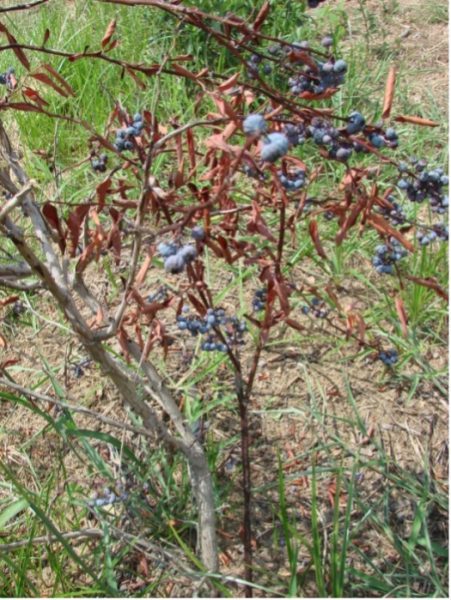
Dieback
Lasiodiplodia Theobromae / Botryosphaeria Sp.
Pathogène :
Fungus
Type:
Risque:
HIGH
Seca de ramas y brotes


¿QUIÉN LO CAUSA?
Lasiodiplodia theobromae and Botryosphaeria sp. They are phytopathogenic fungi responsible for the disease known as dieback in various crops, including blueberry. These fungi can survive in the remains of infected plants and in the soil for long periods, favored by warm, humid conditions. During the initial phases of its development, the spores of the fungus germinate and penetrate plant tissues through wounds or natural openings. As the fungus colonizes internal tissues, it develops mycelium and produces reproductive structures called pycnidia, which release asexual spores called conidia. These conidia are spread by wind, water and contaminated tools, which facilitates the spread of the fungus to new plants. Under optimal conditions, Lasiodiplodia theobromae and Botryosphaeria sp. They can complete their infection cycle in a few weeks, causing significant damage to affected crops.
SÍNTOMAS
Dieback caused by Lasiodiplodia theobromae and Botryosphaeria sp. In blueberries it is characterized by wilting and necrosis of shoots and branches, which reduces the plant's ability to produce fruit. Fungi attack the vascular tissues of the plant, preventing the transport of water and nutrients and causing a decrease in the vitality of the plant.
- Withering and death of shoots and branches.
- Necrosis and darkening of the cortex.
- Appearance of cankers or lesions on the stems.
- Reduction in the production and quality of the fruits.
- Premature defoliation.
- General decline of the plant and loss of vigor.

TEMPERATURA Y HUMEDAD
25°C - 35°C
80% - 100%
VÍAS DE TRANSMISIÓN
Wind, Water, Contaminated tools, Remains of infected plants, Vector insects, Direct contact between plants
Do you want to remove this pest? Choose how you want to treat it.
TRATAMIENTOS
Tratamientos químicos
There are no effective treatments against this pathogen. It is recommended to cut infected branches and remove them. In the case of severe infections, it is recommended to remove the tree. It is important to disinfect tools after contact with an infected tree.
Tratamientos permitidos en agricultura ecológica
There are no effective treatments against this pathogen. It is recommended to cut infected branches and remove them. In the case of severe infections, it is recommended to remove the tree. It is important to disinfect tools after contact with an infected tree.
Tratamientos biológicos
-
Recomendaciones
- Carry out regular inspections of the blueberry crop to detect early signs of infection.
- Prune and eliminate infected parts of the plant, disposing of them properly to prevent the spread of the fungus.
- Avoid wounds on plants during cultural work, as they can serve as entry points for the fungus.
- Disinfect pruning tools and work equipment to reduce the risk of transmission.
- Maintain good soil drainage and avoid excess watering, since excessive humidity favors the development of the fungus.
- Apply preventive and curative fungicides following technical recommendations and rotating active ingredients to avoid resistance.
- Promote integrated pest and disease management practices, combining cultural, biological and chemical methods.
- Use healthy and certified plants when establishing new plantations.
- Improve foliage aeration through adequate pruning and management of planting density.
Enlace patrocinado
Enlace patrocinado
Enlace patrocinado
Enlace patrocinado
Enlace patrocinado
Enlace patrocinado
Effective against all types of fungi
TRATAMIENTOS
Remèdes maison
There are no home treatments
Alliés naturels
Traitements chimiques
There are no treatments for this disease. Treatments are directed at the insect vectors that transmit it. See insect treatments.
RECOMMANDATIONS
- Check the back of the leaves frequently, especially in dry weather.
- Spray water on the leaves to increase humidity and prevent them from settling.
- Keep plants healthy with good watering and adequate light.
- If you see cobwebs or damage, clean the leaves with a damp cloth or pressurized water.
- Use potassium soap or neem oil every few days until they disappear.
Plantes répulsives
Rosemary, Dill, Coriander
PRODUITS RECOMMANDÉS
Enlace patrocinado
Enlace patrocinado
Enlace patrocinado
Enlace patrocinado
Enlace patrocinado
Enlace patrocinado
Effective against all types of fungi
*Los tratamientos recomendados no dejan de ser recomendaciones según las bases de datos de las autoridades y en ningún momento sustituyen las directrices marcadas según la legislación de cada país
*Les produits présentés sont des recommandations et ne sont pas nos propres produits. En tant qu'associés Amazon, nous gagnons des revenus grâce aux achats de produits recommandés.






















